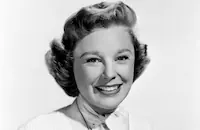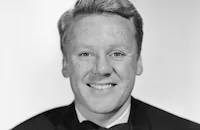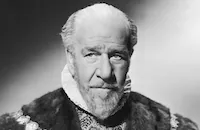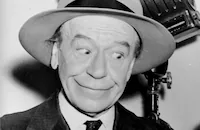Two Girls and a Sailor

Brief Synopsis
Cast & Crew
Richard Thorpe
June Allyson
Gloria Dehaven
Van Johnson
Tom Drake
Henry Stephenson
Film Details
Technical Specs

Synopsis
Sisters Patsy and Jean Deyo grow up watching their parents sing and dance together on the vaudeville circuit, and as soon as they are old enough, start an act of their own. As adults, sober and responsible Patsy constantly warns her younger, more carefree sibling about casual flirtation, admonishing her to save herself for a "good" man. After Jean, who wants to marry a rich man, receives a number of orchids from an admirer who signs himself only as "Somebody," she and Patsy try unsuccessfully to identify him during one of their nightclub performances. Later that night, Jean and Patsy host a "private canteen," inviting dozens of sailors and soldiers to their apartment, and both sisters are attracted to a sailor named Johnny. Johnny is attracted to Jean, who is also the object of Sgt. Frank Miller's affection, but has an enjoyable chat with Patsy. During the evening, Jean points out to Johnny an abandoned warehouse near their apartment and wistfully states that she and Patsy would love to convert the building into a canteen. The next day, the sisters learn from a Mr. Nizby that "Somebody" has purchased the warehouse for them and is paying for its renovation. While Patsy and Jean are inspecting the place, which turns out to be a theatrical warehouse, they discover that Billy Kipp, a popular vaudevillian whom they knew as children, has been secretly living there. The sisters convince Billy, who became a hermit after his wife and son left him years before, to remain at the warehouse. After the building is completely overhauled, the sisters produce an elaborate canteen show paid for by "Somebody," which is attended by hundreds of servicemen, including Johnny and Frank. While Jean and Patsy dance with Johnny, Billy overhears dancer Ben Blue ordering orchids over the telephone and assumes he is "Somebody." Billy rushes to tell Patsy and Jean his suspicions, but they soon realize that Ben is ordering flowers for his wife. When asked by Johnny who she wants "Somebody" to be, Patsy says that she only wants him to be nice and to marry Jean. Patsy then confesses that she wants her own true love to be a poor "straight man." That night, Patsy has a disturbing dream in which she is wooed by Johnny, but ends up losing him to Jean. The next morning, Billy overhears Mr. Nizby place a work order for the canteen and charge the cost to John Dyckman Brown. Sure that he has at last discovered "Somebody's" identity, Billy runs to tell Patsy and Jean the good news. Although Jean is thrilled to learn that the famous millionaire is her admirer, Patsy is disturbed and goes to the Brown mansion to confront him. After accusing first elderly John Dyckman Brown and then his middle-aged son, John Dyckman Brown II, of toying with her sister's affections, Patsy learns that "Somebody" is John Dyckman Brown III, and that he is Johnny. Patsy is devastated, but pretends that she is happy for her sister. After she leaves, Johnny confesses to his father and grandfather that he is actually in love with Patsy, but is afraid to hurt Jean. Later, in New York, a depressed Patsy shows up late at the nightclub and reluctantly tells Jean about Johnny. Jean's excitement about Johnny's money makes Patsy even more glum, and she runs out of club in tears. Unknown to Patsy and Jean, the elder Dyckmans have come to see their show, and are surprised when Billy, having been coaxed onto the stage, performs in the sisters' stead. Jean, meanwhile, realizes that Patsy is in love with Johnny and asks Frank, to whom she has always been attracted, if he is in love with her. When he answers yes, Jean kisses him, and the next day, she announces to Patsy and the Browns that she and Frank, an onion farmer, are marrying. Johnny then proposes to Patsy, and at the canteen that night, Billy is reunited with his long-lost son "Junior," an enlistee who looks exactly like him.

Director

Richard Thorpe
Cast

June Allyson

Gloria Dehaven

Van Johnson

Tom Drake

Henry Stephenson

Henry O'neill

Ben Blue
Carlos Ramírez
Frank Sully
Albert Coates

Donald Meek
Amparo Novarro

José Iturbi

Jimmy Durante

Gracie Allen

Lena Horne

Virginia O'brien
The Wilde Twins
Frank Jenks
Harry James
Helen Forrest

Xavier Cugat

Lina Romay
Frank Holiday Jr.
Bob Priester
George Pitman
Allan Watson
Henry Von Schloeten
Morgan Davies
Arthur Mcculloch
Norman Nielsen

Ava Gardner
Henry Kruse
Joan Thorsen
Doreen Mccann
Eilene Janssen
Sandra Lee

Ghislaine Perreau
Billy Lechner
Allen Forlenza
William Frambes
Don Loper
Charles Hayes
Eve Whitney
Sheldon Jett
Ruth Cherrington
Hazel Dohlman
Lynne Arlen
Patricia Lenn
Florence Wix
Harry Adams
Ed Mortimer
Diana Mumby
Shelby Payne
Fred Rapport
Leo Mostovoy

Eddie Kane
Lee Bennett
Arthur Walsh
Ralph Gardner
James Carpenter
Mickey Rentschler
Doodles Weaver
Fred Beckner
Peggy Maley

Joe Yule
Thomas Louden
Kathleen Williams
Sol De Garda
Crew
Gus Arnheim
Johnny S. Black
George Boemler
John Bonar
Richard Connell
Kay Dean
Al Debru
Dorothy Dodd
Harry Donnelly
Jimmy Durante
Sammy Fain
Manuel De Falla
Al Feldman
Ella Fitzgerald
Ralph Freed
Sammy Gallop
Cedric Gibbons
Paul Groesse
Mann Holiner
Patt Hyatt
Irene
Dorothy Jackson
Harry James
Augustín Lara
Nolan Leary
Margarita Lecuona
Sammy Lee
Gladys Lehman
Jules Lemare
Earl Mcevoy
Jimmy Mchugh
Vic Mizzy
Alberta Nichols
José Pafumy
Joe Pasternak
Robert Planck
Lew Pollack
M. M. Ponce
Erno Rapee
Virginia Rees
Ben Ryan
Douglas Shearer
Georgie Stoll
Georgie Stooll
Robert Surtees
Irving Taylor
Kay Thompson
Harry Tobias
Edwin B. Willis

Photo Collections
Videos
Movie Clip



Trailer
Hosted Intro
Film Details
Technical Specs

Award Nominations
Best Writing, Screenplay
Articles
Two Girls and a Sailor
Two Girls and a Sailor (1944), one of the year's most profitable musicals, was a typical Pasternak extravaganza. It was a pastiche of classical piano by Jose Iturbi, the big band sounds of Harry James, Xavier Cugat's Latin rhythms, comedy from Jimmy Durante and Gracie Allen, plus assorted cameos and appealing young newcomers in the leading roles. June Allyson and Gloria DeHaven play a sister song-and-dance team who open up a servicemen's canteen filled with big-name musical acts. Along the way, they get involved with sailor Van Johnson and soldier Tom Drake, and romantic complications ensue before each girl gets the right boy. The plot was MGM's second remake of the backstage story, The Broadway Melody (1929).
June Allyson had appeared in a few film shorts in the late 1930's, but it wasn't until she had a featured role in the Broadway show Best Foot Forward (1941) that MGM signed her to a one-year contract and brought her to Hollywood to appear in the 1943 film version of that show. After six months, unimpressed studio boss Louis B. Mayer was about to drop Allyson, when producer Joe Pasternak came to her rescue. According to Allyson, Pasternak urged Mayer to look at her screen test. "Look at her eyes and listen to her voice. Don't pay attention to anything else about her. Those are distractions we can iron out." Mayer did, and was convinced. After a couple of featured roles in other films, Allyson was given one of the leads in Two Girls and a Sailor. Allyson claims in her autobiography that she was originally supposed to play the glamorous sister, but that her boyfriend (and later husband) Dick Powell told her to ask to play the plain sister, since it was a better part. It was good advice because the film made her a star.
Like Allyson, Gloria DeHaven was also being groomed for stardom though she would never become as popular. The two actresses had already appeared together in two films, Best Foot Forward and Thousands Cheer (1943). But they were similar types, and whether it was the roles they played in Two Girls and a Sailor, or some indefinable quality, most critics agreed with Bosley Crowther in the New York Times that "It's a tossup ...as to which is the lovelier girl. But since Miss Allyson is made the more appealing - and makes herself so - she deserved the favored nod."
Van Johnson, a former chorus boy who had also been in Best Foot Forward on Broadway, was the studio's newest leading man, having just scored a big hit in A Guy Named Joe (1943). With Two Girls and a Sailor, he began an on-screen romance with June Allyson which would last through five films. They were the ideal couple, the boy next door and the girl next door. Nearly 60 years later, Johnson and Allyson, along with fellow MGM alumna Gloria DeHaven, remain close friends. And Two Girls and a Sailor remains a delightful (and for all its star power, unpretentious) time capsule of the top musical entertainment of the era.
Director: Richard Thorpe
Producer: Joe Pasternak
Screenplay: Richard Connell, Gladys Lehman
Editor: George Boemler
Cinematography: Robert Surtees
Costume Design: Irene, Kay Dean
Art Direction: Cedric Gibbons, Paul Groesse
Musical Director: Georgie Stoll
Principal Cast: Van Johnson (John Brown III), June Allyson (Patsy Deyo), Gloria DeHaven (Jean Deyo), Jimmy Durante (Billy Kipp), Tom Drake (Frank Miller), Henry Stephenson (John Brown I), Henry O'Neill (John Brown II).
BW-125m. Closed captioning.
by Margarita Landazuri

Two Girls and a Sailor
TCM Remembers Van Johnson - Important Schedule Change on TCM In Honor To Salute VAN JOHNSON
The new schedule for the evening of Tuesday, December 23rd will be:
8:00 PM In the Good Old Summertime
9:45 PM A Guy Named Joe
12:30 AM Thirty Seconds Over Tokyo
2:30 AM The Last Time I Saw Paris
4:30 AM Thrill of a Romance
Van Johnson (1916-2008)
Van Johnson, the boyish leading man whose clean cut, All-American appeal made him a top box-office draw for MGM during World War II, died on December 12 in Nyack, New York of natural causes. He was 92.
He was born Charles Van Dell Johnson on August 25, 1916, in Newport, Rhode Island. By his own account, his early childhood wasn't a stable one. His mother abandoned him when he was just three and his Swedish-born father offered little consolation or nurturing while he was growing up. Not surprisingly, Johnson found solace in singing and dancing lessons, and throughout his adolescence, he longed for a life in show business. After graduating high school in 1934, he relocated to New York City and was soon performing as a chorus boy on Broadway in shows such as New Faces of 1936 and eventually as an understudy in Rodgers and Hart's musical, Too Many Girls in 1939.
Johnson eventually made his way to Hollywood and landed an unbilled debut in the film version of Too Many Girls (1940). By 1941, he signed a brief contract with Warner Bros., but it only earned him a lead in a "B" programmer Murder in the Big House (1941); his contract soon expired and he was dropped by the studio. Johnson was on his way back to New York, but as luck would have it - in the truest Hollywood sense - friends Lucille Ball and Desi Arnaz introduced him to Billy Grady, a lead talent scout at MGM, which was currently Ball's new studio. Johnson was signed up and almost immediately MGM had a star on its hands.
It might have been slow going at first, with Johnson playing able support in films such as Dr. Gillespie's New Assistant and The War Against Mrs. Hadley (both 1942). By 1943 the studio capitalized on his broad smile and freckles and starred him in two of the studio's biggest hits: A Guy Named Joe and The Human Comedy. Those two films transformed him into a boxoffice draw with a huge following, particularly among teenage girls. A near fatal car accident that same year only accentuated the loyalty of his fans, and his 4-F status as the result of that accident created an opportunity for him when so many other leading actors of the era (James Stewart, Clark Gable) were off to war. Johnson was quickly promoted as MGM'sleading man in war heroics and sweet romancers on the big screen: The White Cliffs of Dover, Thirty Seconds Over Tokyo (both 1944), Thrill of a Romance, the episodic Week-End at the Waldorf (both 1945), and a musical remake of Libeled Lady entitled Easy to Wed (1946).
Hits though these were, it wasn't until after the war that Johnson began to receive more dramatic parts and better material such as supporting Katharine Hepburn and Spencer Tracy in the political farce State of the Union (1948). other significant roles included the well-modulated noir thriller The Scene of the Crime, the grim war spectacle Battleground (both 1949), the moving domestic drama Invitation (1952) in which he played a man who is paid to marry a woman (Dorothy McGuire) by her father. Before he left MGM, he closed his career out in fine form with the sweeping musical Brigadoon, co-starring Gene Kelly and Cyd Charisse; and the lilting soaper The Last Time I Saw Paris (both 1954) with Elizabeth Taylor.
After he left MGM, the parts that came Johnson's way weren't as varied, but he had his moments in The Caine Mutiny (1954), the beguiling romance drama Miracle in the Rain (1956) with Jane Wyman; and his lead performance in one of the first successful made for-TV-movies The Pied Piper of Hamelin (1957). By the '60s, Johnson returned to the stage, and played the title role in London's West End production of The Music Man. He then returned to Broadway in the drama Come on Strong. He still had a few good supporting parts, most notably as Debbie Reynolds' suitor in Norman Lear's scathing satire on marital differences Divorce American Style (1967); and television welcomed his presence on many popular shows in the '70s and '80s such as Maude, Fantasy Island, The Love Boat and of course Murder She Wrote. There was one last graceful cameo in Woody Allen's The Purple Rose of Cairo (1985), yet for the most remainder of his career, Johnson worked mainly on the dinner theater circuit before retiring from showbiz completely by the mid-90s. He is survived by a daughter, Schuyler.
by Michael T. Toole
TCM Remembers Van Johnson - Important Schedule Change on TCM In Honor To Salute VAN JOHNSON
Quotes
Trivia
Notes
The working titles of this film were The Tale of Two Sisters and Two Sisters and a Sailor. In addition to the above-listed numbers, the film includes instrumental excerpts from "Wabash Blues" by Fred Meinken, "Tentación de amor" by Xavier Cugat and Fausto Curbelo, Cugat's "The Thrill of a New Romance" and "Mulata rumbera." The film also features a comic, classical piece in which Gracie Allen plays a simplistic piano "concerto" with an orchestra led by British conducter Albert Coates. According to M-G-M publicity material, Allen had performed her concerto at Carnegie Hall, the Los Angeles Philharmonic Auditorium and the Hollywood Bowl prior to the film's production. Robert Planck, not credited cameraman Robert Surtees, is listed in an early Hollywood Reporter production chart as director of photography.
Although this film was shot after Bathing Beauty, it was released shortly before it, and therefore marked Latin entertainer Carlos Ramírez' American feature-film debut. The film also marked June Allyson and Gloria DeHaven's first starring roles, although both had been in films before. Allyson's first screen appearance was in M-G-M's 1943 musical Best Foot Forward . According to a modern interview, Allyson was originally cast in DeHaven's role. As a child, DeHaven, like the character she plays in the picture, accompanied her parents, entertainers Carter DeHaven and Flora Parker, during their vaudeville circuit tours. Although Two Girls and a Sailor was not Tom Drake's first film, "Sgt. Frank Miller" was his first significant role. The Hollywood Reporter review described him as a "most promising leading man prospect."
Hollywood Reporter news items and M-G-M publicity items add the following information about the production: Felix Jackson, Leo Townsend, Carl Dudley and Herbert Baker worked on drafts of the film's screenplay, but their contribution to the final film has not been confirmed. George Sidney was initially assigned to direct the picture, and Kathryn Grayson was to star. Al Dubin, Ralph Blane and Hugh Martin were originally hired to write the film's music, along with credited composer Georgie Stoll, and Don Loper was to be the picture's dance director. (Loper did appear in the film as a "small town wolf.") Although Alan Reed, playing his "Falstaff Openshaw" character created on Fred Allen's radio show, singer Dennis Day, and comedienne Nancy Walker were announced as cast members, they did not appear in the completed film. In August 1943, Hollywood Reporter reported that Duke Ellington was to accompany Lena Horne on a song composed by Johnny Green and Jack Lawrence, but Horne's only number was Johnny S. Black's "Paper Doll."
Hollywood Reporter also claimed that M-G-M was seeking a Jimmy Durante "look-alike" for the role of Durante's screen son, "Junior." Although the CBCS lists Buster Keaton in that part, Durante actually played the role. Virginia O'Brien's comic interpretation of the song "Take It Easy" was added after principal photography was completed. The film was shown to the Army prior to its national release and Allyson "plugged" it in Spanish and Portuguese for South American broadcasts. In addition, Ramírez and Xavier Cugat made Spanish and Portuguese language trailers for the film's Latin American release. The National Board of Review named Two Girls and a Sailor one of its "outstanding pictures." The film was nominated for an Academy Award in the Writing (Original Screenplay) category. According to Hollywood Reporter, the song "Sweet and Lovely" enjoyed a revival after the release of this film. Modern sources note that Gene Corcoran, playing tenor saxophone, and Mickey Scrima, playing drums, appeared in the film as part of Harry James's band.

















